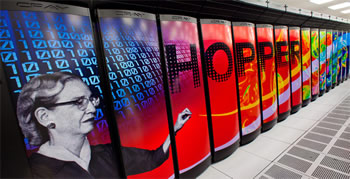Computing Sciences

NERSC Cray XT5 Hopper Supercomputer cluster at the Lab's Oakland Scientific Facility (OSF)
Berkeley Lab scientists and computing resources located at Berkeley Lab have helped pioneer our understanding of climate change, how proteins conduct life’s fundamental work, and how a star explodes — to name just a few advances. Expect even more breakthroughs in the future. Berkeley Lab is at the vanguard of high-performance computing and high-speed networking, both of which are required by today’s data-intensive, international scientific collaborations.
National Energy Research Scientific Computing Center (NERSC)
Located at Berkeley Lab, NERSC is the flagship supercomputer facility for the Office of Science in the Department of Energy. The user facility is a world leader in providing resources that accelerate scientific discovery through computation. At any given time, approximately 3,000 scientists use the facility to tackle more than 400 projects ranging from climate research and astrophysics to accelerator physics and materials sciences.
ESnet (Energy Sciences Network)
ESnet is a high-speed network serving scientists and their collaborators supported by the Department of Energy. Managed and operated by ESnet staff at Berkeley Lab, the network provides connections to all major Department of Energy sites with high performance speeds. It enables researchers at national laboratories, universities, and other institutions to collaboratively address some of the world's most important scientific challenges – such as the search for origins of matter at the Large Hadron Collider near Geneva, Switzerland. ESnet will soon develop a prototype 100 gigabits per second Ethernet network to connect DOE supercomputer centers at speeds 10 times faster than current technology – creating the world’s fastest computer network.
Computational Research
Scientists in Berkeley Lab’s Computational Research Division conduct research and development in computer science and applied mathematics. They develop computational tools, such as breathtaking computer visualizations of the planet’s surface temperature, which enable scientists to capitalize on today’s cutting edge computing resources.

